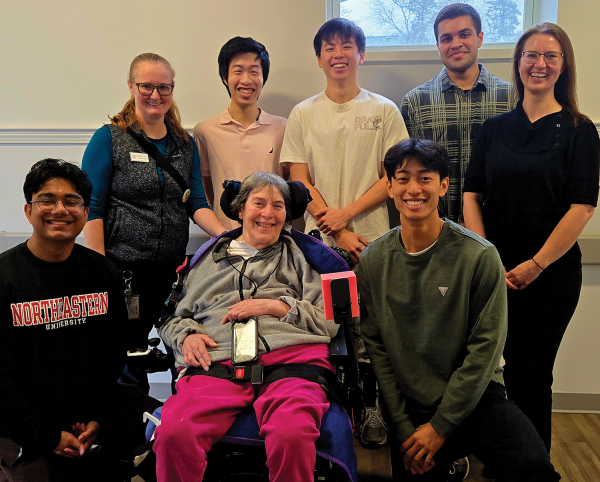December 31, 2024

Professor Kristy Johnson with Northeastern students Steven Lam, Ishann Jhawar, Rithvik Katikaneni, Jimmy Cheung, and Kevin Chen, Boston Home resident, Nan, and TBH assistive technology coordinator, Corrine Curran. TBH photo
An ongoing collaboration with Northeastern University continues to produce innovative solutions to quality-of-life issues for residents at the Dorchester Avenue campus of The Boston Home (TBH).
Last spring, students from the school’s Enabling Engineers course equipped one of the residents at TBH with an ultrasonic sensor that helps wheelchair users to navigate their moves. In the fall, a fresh team of students returned to Dorchester with an even more sophisticated sensor that alerts users to tilt their wheelchairs back to relieve pressure on the body.
“The focus of the class is to match undergraduate engineering students with individuals in the community with a disability who have an unmet need,” said Kristy Johnson, the professor who leads the class.
Five students — Steven Lam, Ishann Jhawar, Rithvik Katikaneni, Jimmy Cheung, and Kevin Chen — were matched with Nan, a TBH resident. Like many other non-ambulatory patients and wheelchair users, Nan suffers from pressure sores caused by prolonged sitting.
The only way to prevent or improve this type of sore is to offload weight. To help Nan do so, the students created the “Tilt-o-Matic.” The device reminds Nan to tilt her wheelchair throughout the day. It also tracks the angle and duration of the tilt and alerts her when the necessary tilt time is complete.
“The ideal standard is tilting for three minutes, every thirty minutes,” explained fourth-year computer engineering major Steven Lam. “Right now, the main goal is just incorporating tilting more so into the daily routine of the residents.”
Lam and his classmates decided that tilting six times a day would be a good start for Nan.
“Our design was split into four boxes,” said fellow fourth-year student Rithvik Katikaneni. “One housed all the controller battery and main core competent technology. The second housed the gyroscope under the wheelchair, which helps track the angle of the tilt, and the third box houses all the components for the audio.”
He added, “The last box is the one right in front of the left armrest of the wheelchair. It houses one large star, which essentially gives the user the reminder that it is time to tilt by blinking. Then there are six little stars underneath it that they collect every time they perform a tilt.”
The students hope the low-cost device will improve Nan’s day-to-day quality of life. “A lot of times when we work in a co-op or on random class projects, it’s usually a project that kind of has loose ends; we don’t know if it ever becomes something or it is ever useful,” said Ishaan Jhawar, also a fourth-year student. With respect to this production, he said, “it’s exciting to see the fruits of our labor.”


